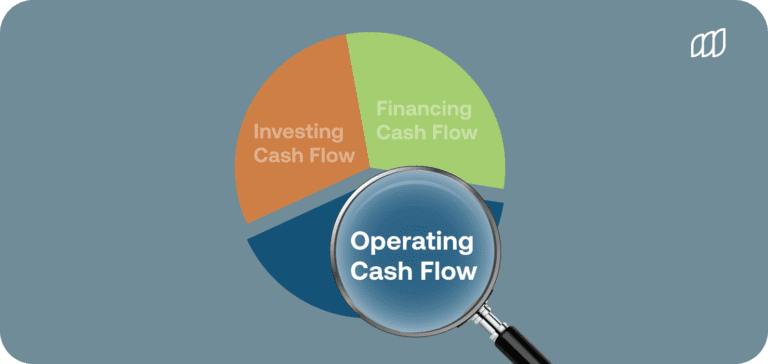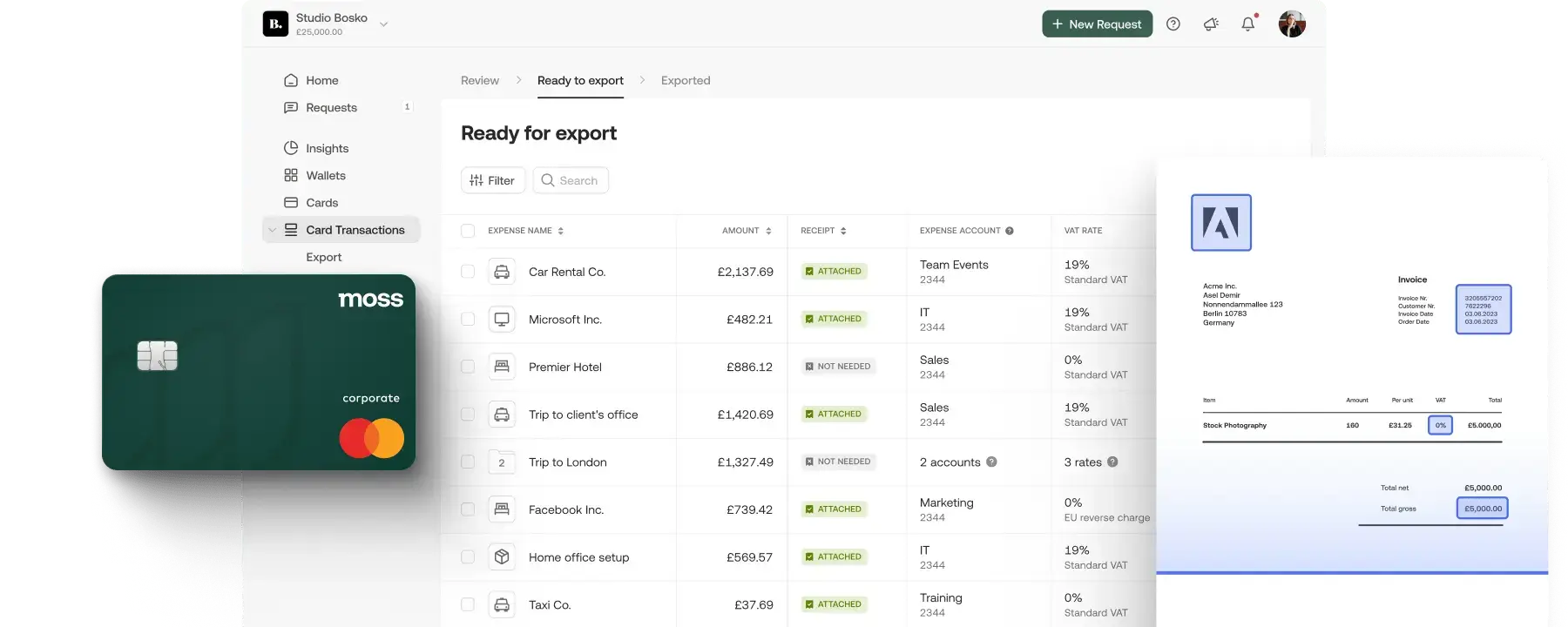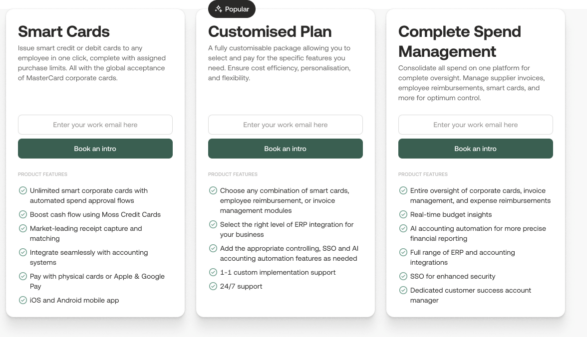How solvent is a company? To answer this question, there are various helpful key figures. One of them, the operating cash flow, is often referred to in this context. This key figure is essential for giving better spend visibility to internal management and external stakeholders, like investors or lenders. Our guide explains what operating cash flow is, what it indicates, and how it is calculated.
What is operating cash flow?

The operating cash flow (abbreviated to OCF) is a key figure from business administration that indicates on the one hand the competitiveness and on the other hand the internal financing capability of a company. With the operating cash flow, the company can identify what amount of liquid assets it generates within a specified period of time – it is, you might say, the balance between cash inflows and cash outflows from ordinary business activities during a certain time. Or simply put, it shows how much money the company takes in during its normal day-to-day business. When it comes to controlling spend and keeping business costs at bay, cash flow is one of the most important metrics there is.
For businesses, the key figure of operating cash flow is significant, because if you want to invest and thus remain competitive, you first need the appropriate capital. With the cash flow, the company can evaluate whether it has the sufficient financial resources to carry out new investments. This makes this indicator an indispensable instrument for financial controllers and general financial planning and analysis.
Cash flow or operating cash flow? These are the differences
Cash flow is a familiar term for many, but operating cash flow often is not. Do they both mean the same thing – and if not, how do they differ? Operating cash flow is only one part of a company’s cash flow: the entire cash flow comprises more than that and is just as much a balance sheet ratio for companies. It indicates how much capital has flowed in or out within a year.
Cash inflows and outflows are contrasted to determine the company’s liquid funds. If the cash flow is positive – that is, if the company has generated sufficient liquid resources – the result is an annual net profit. If it is negative, this represents a so-called net loss for the year. The operating cash flow, on the other hand, only accounts for the cash flows of the company’s ordinary activities. Thus, it only reflects a part of the total incoming and outgoing payments.
Operating income and expenses include, for example:
- customer payments
- supplier payments
- wages and salaries
- production costs
- taxes
- interest
In addition to the operating cash flow, the overall cash flow includes the financing cash flow and the investing cash flow. While the financing cash flow indicates how much cash a company has obtained from capital measures or spent on them in a certain period, the investing cash flow defines the inflows and outflows from disinvestments or investments.
Net operating cash flow vs. gross operating cash flow
One distinction within operating cash flow is between net operating cash flow and gross operating cash flow. Net operating cash flow includes the interest and tax burden in the calculation, whereas gross operating cash flow does not. Interest and tax burdens are affected by the financial structure and gearing of the company.
Cash flow statement for financial reporting

The cash flow statement is one of the three core financial statements that are common in financial reporting – complementing the income statement and the balance sheet. It summarises where the company’s cash derives from, how it is spent, and how the liquid funds develop within a financial period. For this purpose, the three aforementioned key figures are used:
- Operating Cash Flow: Operating cash flow relates to the essence of the business: current revenues such as customer payments and current expenditure such as salaries, supplier payments, or production costs. For this reason, it has the greatest significance for assessing the company’s financial situation.
- Financing Cash Flow: The financing cash flow reveals where the company’s capital comes from – e.g., from loans or proceeds from shares and dividends. These are offset by loan repayments as well as dividend or interest payments.
- Investing Cash Flow: Investing cash flow indicates what companies spend on long-term investments, such as property, buildings, or machinery – and at the same time what income they generate from their sales.
The operating cash flow is particularly informative for the assessment of a company’s performance. Unlike the financing cash flow and the investing cash flow, it refers to the company’s day-to-day business – its operating business.
Operating cash flow formula: how the OCF is calculated

Businesses, investors, or lenders may calculate operating cash flow in two ways: the indirect method and the direct method. The indirect method is usually preferred for accounting purposes.
Indirect method
Because it is easier to use, the indirect method is the most common for determining the operating cash flow of a company. The starting point is the result of the profit and loss account – the company’s net profit or net loss for the year. The indirect calculation of the operating cash flow is done by subtracting the non-cash income and adding the non-cash expenses.
The formula for the indirect method of calculating operating cash flow is:
Operating cash flow = net income – non-cash income + non-cash expenses
Direct method
Alternatively, the operating cash flow can be calculated with the direct method. This involves the addition of all cash transactions in a business period. In simple terms, all operating outflows are deducted from inflows.
The formula for the direct method of calculating operating cash flow is:
Operating cash flow = cash income – cash expenditure
Indirect and direct method in comparison
Since the direct method requires much more internal corporate data, the indirect method is mostly used in practice to calculate the operating cash flow. The time consumption for the indirect calculation is less and the data necessary for the evaluation can be obtained more easily. But: the US Financial Accounting Standards Board (FASB), which provides uniform financial communication standards, recommends the direct method instead, as it presents a more accurate picture of a company’s actual cash flow.
Advantages and disadvantages of operating cash flow

The operating cash flow is one of the most important indicators of how sound a company is. However, looking at operating cash flow alone does not give a holistic picture of a company’s financial situation.
Advantages
The operating cash flow is a key figure that, in contrast to other performance figures such as the balance sheet or net profit, has several advantages: it is less abstract, less susceptible to influence and manipulation, and thus more significant.
Because of these advantages, operating cash flow is preferably used as an evaluation criterion for the liquidity and funding capacity of companies.
Disadvantages
The operating cash flow does provide information about the current business of a company – but often based on a past perspective. The operating cash flow is calculated retrospectively, for example for the first quarter of 2022. If this operating cash flow is relied on for a loan approval in May 2022, for example, the company’s financial situation may already have changed in the meantime.
Hence, the key figure of the operating cash flow alone cannot always provide reliable information. To gain a proper picture of a company’s success and liquidity, a variety of financial KPIs should be analysed. Those who comply with this and can present reliable data have benefits with investors and lenders.
The significance of operating cash flow

The operating cash flow allows conclusions on the success of a company in its core business. The key figure can be used, for example, to answer the following questions:
- Is the company capable of making investments from its own resources?
- Is the company potentially solvent?
- How successful is the company?
- How stable is the ordinary business?
- How is the company’s debt repayment?
Based on the result of the cash flow analysis, the operating cash flow may be either positive or negative.
What does a positive operating cash flow indicate?
A positive operating cash flow suggests that the company has sufficient liquid funds and is generating sustainable surpluses. This means that it can make investments from its own resources without debt financing. Because this can be a decisive advantage over competitors, operating cash flow is an important indicator for investors.
Shareholders and financial institutions also rely on the operating cash flow. It is an evaluation criterion for the company’s creditworthiness: the higher the cash flow generated, the more debt the company can repay. High and long-term loans are less critical with a high operating cash flow.
What does a negative operating cash flow imply?
A negative cash flow, on the other hand, is a first warning sign: if the key figure is negative for longer than just a short time, it means that the company is not generating sufficient liquid funds in its normal business in the long term. Thus, the company loses its liquidity. The ultimate result of a persistently negative operating cash flow is illiquidity and insolvency of the company.
But you must not look at the operating cash flow exclusively: without the entire cash flow statement, the balance sheet, and the profit and loss statement the success, internal financing capability, and competitiveness of a company cannot be evaluated conclusively. For a reliable statement, you need a comparative figure, because a larger company naturally produces a larger cash flow than a smaller one – even if it is less successful.
In practice, the operating cash flow is therefore often contrasted with the company’s profit, revenue, or capital to be able to compare the key figures.
Moss: automated cost management for more control

It is not only the company itself that takes an interest in its operating cash flow: investors and lenders alike are keen to know what the economic situation of a potential partner is like.
Companies find support in Moss: the accounting department, employees, and management can trace every single payment with the help of precise reporting and forecasts. Expenditures can be reviewed in detail and visualised. With the Moss Dashboard, all employee expenses and recurring payments can be monitored in real time – and superfluous expenditures can be monitored and managed with comprehensive budget controls. With Moss smart corporate cards, you can track and filter all of your transactions by expense category and vendor.
Moss allows the company to optimise its internal expenses and not lose control of the operating cash flow in its day-to-day business. As a result, trends and developments can be identified at an early stage and the company can concentrate on what really matters.
FAQs
The operating cash flow is part of the total cash flow of a company. It can indicate how successfully the company performs on a day-to-day basis – in its operating business. The focus is on income from customer payments or on expenditures such as salaries as well as supplier or production costs. The net operating cash flow also considers tax and interest payments.
The calculation of the operating cash flow provides information on whether the company generates sufficient income in its day-to-day business to cover its internal expenses. The business key figure can be determined with the help of two methods: the indirect and the direct method. Due to the simpler handling and the reduced data collection, the indirect method is mostly applied.
The operating cash flow is just one part of the cash flow. The cash flow as such is a combination of three components: the operating cash flow, the financing cash flow, and the investing cash flow. Financing cash flow covers loans and proceeds from shares, while investing cash flow concerns the purchase and sale of long-term investments such as property, buildings, or machinery.
Information about the operating cash flow is of great significance not only for the company itself, but also for potential investors and lenders. The analysis of this key figure allows reliable statements about the liquidity and thus the competitiveness of the company – a decisive criterion for future investments and credit assessments.
A positive operating cash flow is a good sign for the company: it proves that the company has sufficient liquid funds and basically generates surpluses, which makes investments possible without debt capital. For investors, a positive operating cash flow is therefore an important indicator, especially in comparison with potential competitors.
If the key figure is negative, this means that the company does not have enough incoming payments from ordinary business activities to cover its current costs. Since a persistent negative operating cash flow leads to illiquidity and thus insolvency of the company, optimisation measures should be taken in a timely manner.








